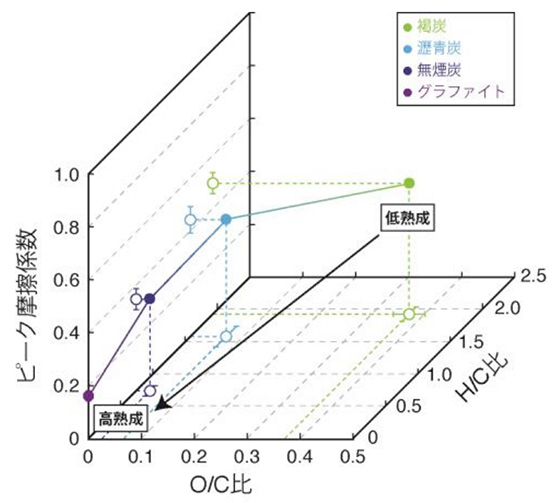Figure
Carbonaceous material in faults affects earthquake dynamics
Associate Professor Hirono Tetsuro and Dr. Shunya Kaneki from Osaka University conducted laboratory experiments simulating seismic slip, clarifying the possibility that thermal chemical reaction of carbonaceous material (CM) could affect slip behaviors during subduction zone earthquakes.
In subduction zones, plate tectonic boundaries where two plates converge, one plate is thrust beneath the other. This process results in earthquakes, causing huge tsunami and inflicting terrible damage as seen in the 2004 Indian Ocean earthquake and tsunami and the 2011 Tohoku earthquake.
The plate boundary fault near the trench axis is rich in clayey minerals derived from the continent. Because these clayey minerals have lower frictional strength than other minerals, it was pointed out that these clayey minerals could affect slip behavior during a subduction zone earthquake. CM deposited in trenches and their surrounding areas in large amounts is brought into a deep part of the fault due to plate subduction and is contained in the plate-boundary fault; however, how CM and its diagenetic thermal maturation relate to subduction zone earthquakes was poorly understood.
Focusing on CM in faults in plate-subduction zones that cause earthquakes, the two researchers conducted rotary-shear friction experiments designed to reproduce seismic slip in CM-bearing faults. Results showed that the peak friction coefficient decreased as maturation of CM progressed.
Plate subduction carries the plate deep into the earth with carbonization of CM proceeding as temperature and pressure increase. For this reason, in carbon-bearing plate-boundary faults, the presence of clayey minerals and thermal maturation of CM could decrease the frictional strength of faults and affect the seismic rupture propagation process.
The peak frictional coefficient of low maturity lignite is about 0.5, but the peak frictional strength of fully matured CM, or graphite, becomes extremely low at 0.1, so the energy required to advance a rupture front becomes small. These changes in CM due to thermal maturation affect the parameter that governs the dynamics of earthquake rupture propagation.
In this study, they revealed that in the area of the plate boundary fault rich in CM, lignite’s graphitization occurred from a shallow part to a deep part of the fault and that the increase of CM maturity (from lignite to graphite) affected the frictional strength of faults and the earthquake rupture propagation process.
Around the edge of the Pacific Ocean, a large amount of CM slid from land is found in plate-subduction trenches, and active faults containing a wealth of CM and graphite are found in land areas as well. The researchers clarified the effect of thermal maturation of CM on the frictional strength of faults and earthquake rupture propagation, which will lead to further understanding of mechanisms of various earthquakes: earthquakes in plate-boundary faults in subduction zones as well as those along an intracontinental fault.

The article, “Diagenetic and shear-induced transitions of frictional strength of carbon-bearing faults and their implications for earthquake rupture dynamics in subduction zones,” was published in Scientific Reports at DOI: https://doi.org/10.1038/s41598-019-44307-y.
Related links
Hirono Group, Department of Earth and Space Science, Graduate School of Science, Osaka University











